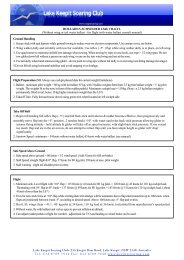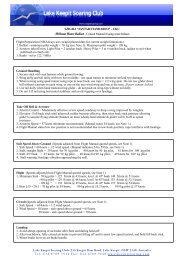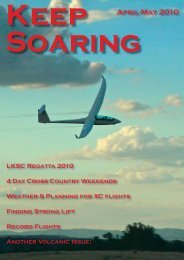Flying the Morning Glory Dust Devil Dash Hitting the Silk New ...
Flying the Morning Glory Dust Devil Dash Hitting the Silk New ...
Flying the Morning Glory Dust Devil Dash Hitting the Silk New ...
Create successful ePaper yourself
Turn your PDF publications into a flip-book with our unique Google optimized e-Paper software.
<strong>Hitting</strong> <strong>the</strong> <strong>Silk</strong><br />
The parachute may remain inflated after landing, if winds are<br />
greater than 10kts. If you are being dragged across <strong>the</strong> ground by<br />
high winds, roll onto your back. The backpack will provide some<br />
protection from abrasion. Reach up and grab one of <strong>the</strong> lower<br />
rigging lines of <strong>the</strong> parachute and pull down hand over hand<br />
until <strong>the</strong> canopy is distorted enough to collapse.<br />
If you are landing in water, turn <strong>the</strong> parachute to face into<br />
wind to land as you would for a normal landing. Facing into<br />
wind is absolutely necessary for all water landings.<br />
Release <strong>the</strong> chest strap as you descend under <strong>the</strong> parachute.<br />
This will save time in <strong>the</strong> water.<br />
Be aware that if you land in water facing into wind, you may<br />
be towed across <strong>the</strong> water on your back (face up) if <strong>the</strong> wind<br />
strength is high.<br />
If you land facing down wind, you will enter <strong>the</strong> water face<br />
down and may be dragged under.<br />
After landing in <strong>the</strong> water, release both leg strap snaps.<br />
Discard <strong>the</strong> parachute and swim away. Always swim up-wind<br />
and up-current away from <strong>the</strong> parachute to avoid entanglement.<br />
Once it’s water logged, <strong>the</strong> parachute will sink!<br />
If <strong>the</strong>re are power lines in <strong>the</strong> vicinity, steer away from<br />
<strong>the</strong>m downwind. If you are unable to avoid power lines, push<br />
your feet firmly toge<strong>the</strong>r, turn your head to <strong>the</strong> side and try not<br />
to touch more than one line.<br />
If you find yourself suspended above <strong>the</strong> ground, make sure<br />
power has been disconnected before a rescue attempt is made.<br />
There are several instances of rescuers being electrocuted trying<br />
to save someone from power lines while <strong>the</strong> person hanging<br />
from <strong>the</strong> power lines survived.<br />
Unless you are sure that <strong>the</strong> power has been disconnected,<br />
don’t let anyone near you. Remember that most high voltage<br />
lines will have a circuit breaker that will automatically attempt to<br />
reconnect <strong>the</strong> power a number of times.<br />
Always steer <strong>the</strong> parachute to avoid trees. If a tree landing<br />
is unavoidable, place your feet and knees firmly toge<strong>the</strong>r, tuck<br />
your elbows into your stomach, protect your face with your<br />
hands. Place your chin on your chest and hold on. Once you are<br />
in <strong>the</strong> trees, you can ei<strong>the</strong>r use your parachute lines to lower<br />
yourself to <strong>the</strong> ground, or better, to tie yourself to <strong>the</strong> tree until<br />
help arrives.<br />
As a side note, many hang glider and paraglider pilots carry a<br />
roll of dental floss in <strong>the</strong>ir harnesses which is strong enough to<br />
be user to raise a rope from <strong>the</strong> ground.<br />
October November 2009<br />
Improving <strong>the</strong> Odds<br />
Assuming you have a parachute, it is repacked regularly and<br />
you know how to get out of your aircraft, <strong>the</strong>re are several things<br />
you can do to improve <strong>the</strong> odds of bailing out successfully.<br />
Practice<br />
Mental rehearsal<br />
Static line parachutes<br />
NOAH<br />
Aircraft Rescue Systems and Ballistic Parachutes<br />
Obviously <strong>the</strong> first thing is to practice. You can do this in<br />
at least two ways. One is to rehearse <strong>the</strong> bail-out routine in <strong>the</strong><br />
cockpit of any aircraft that you fly. Use a check list such as CBBC,<br />
look, touch and think.<br />
Mental rehearsal or visualisation is a great technique. Almost<br />
all athletes use mental rehearsal before <strong>the</strong>y perform. Visualisation<br />
is a very powerful tool and <strong>the</strong>re is plenty of evidence to suggest<br />
that techniques like this can make a really significant difference<br />
in <strong>the</strong> physical world. You can do this almost anywhere, not just<br />
in bed or sitting down. I was undergoing a regular and painful<br />
dental procedure (is <strong>the</strong>re any o<strong>the</strong>r sort?) and I found lying in<br />
<strong>the</strong> chair and visualising winch launch emergencies was a great<br />
way to put my mind somewhere else.<br />
If you do visualisation well, you may find yourself breaking<br />
into a sweat or your pulse racing. This is probably a good thing<br />
since regular exposure to <strong>the</strong> bail-out situation or <strong>the</strong> idea of it<br />
can remove <strong>the</strong> panic factor… after all, some people jump out<br />
of aeroplanes just for fun!<br />
Static line parachutes. A static line parachute can be<br />
opened in two ways. One is using <strong>the</strong> rip cord as normal. The<br />
o<strong>the</strong>r way is to have a static line on your parachute which is<br />
attached to a strong point on <strong>the</strong> glider. Most gliders have <strong>the</strong>se<br />
already fitted, but it’s fairly easy to install one or to connect to an<br />
existing structure.<br />
Using a static line parachute should completely eliminate<br />
one part of <strong>the</strong> deployment procedure. And it should work even<br />
if you cannot get a hand on <strong>the</strong> rip cord. If <strong>the</strong> static line system<br />
fails for some reason, you will know pretty soon and can fall back<br />
on pulling <strong>the</strong> rip cord.<br />
There are a few possible disadvantages. One is that <strong>the</strong> static<br />
line gets tangled around your arm or neck as you leave <strong>the</strong> glider.<br />
Keep Soaring October-November 2009 Page 32








